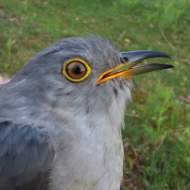It's been a warm few weeks here and much of the local wildlife has been busy in the process of breeding and raising young. I've seen plenty of fledgling birds lately such as this cute young robin.
The canada geese nursery looks to have had a successful year with many goslings still in the area.
You can see the difference in some of the older goslings like the one at the front of the last picture- less fluffy and the black markings are starting to appear on the head.
I managed to find what I think is the nest of a green woodpecker nearby. I kept hearing lots of noise at one tree and knew it was a nest but couldn't identify what species it belonged to. Then one day I saw a green woodpecker on the tree and saw some holes which look like woodpecker nests. With the sound on, you should be able to hear the noise in this clip.
This is what I think is probably this year's nest:
The cold winter and late spring has affected some local wildlife including the house martins. They arrived very late and are still in the process of building nests in the eaves of houses. I've yet to see any young poking out of them and I fear they may not produce any young this year.
The BTO tagged another set of cuckoos this year and I was excited to see that one of them, Bowie, visited my patch two weeks ago. There are plenty of cuckoos not far away in the New Forest but I was surprised to see one so close to the town. Thanks to Bowie's visit a satellite view of my patch made a brief appearance on week 2 of Springwatch!
 |
| Bowie the Cuckoo (Source) |
I saw one of the Avon roe deer recently which looked absolutely stunning in it's summer coat.
I've also seen plenty more insects this week such as this lovely blue-tailed damselfly.
I was particularly drawn to this individual due to it's bright pink thorax. The females of this species, of which this is one, have a variety of colour forms with this form known as "rufescens".
I found several different species of longhorn beetles which are really distinctive insects.
 |
| Banded Longhorn Beetle |
 |
| Spotted Longhorn Beetle |
 |
| Stenurella melanura |
There were lots of caterpillars out today too. Everywhere I looked there were these black ones:
These are probably alder leaf beetle larvae which means they are not technically caterpillars at all. A lot of people probably don't realise that all insects go through a similar metamorphosis to butterflies. This species was introduced to the UK in the 19th century but there were no records between 1946 and 2004. A colony appeared in Manchester in 2004 and then the species was found here in South Hampshire in 2014.
I also saw small cinnabar moth caterpillars on lots of ragwort plants and on one plant they were quite well developed already.
On a tree trunk there was a singular green caterpillar.
This individual looked very vulnerable on the trunk as birds love to eat the green caterpillars. This is the larvae of a common quaker moth- this species flies in March and April so this individual will not become an adult moth the early spring next year.
That's all for today but I shall be back next week with June's Nature News!












No comments:
Post a Comment